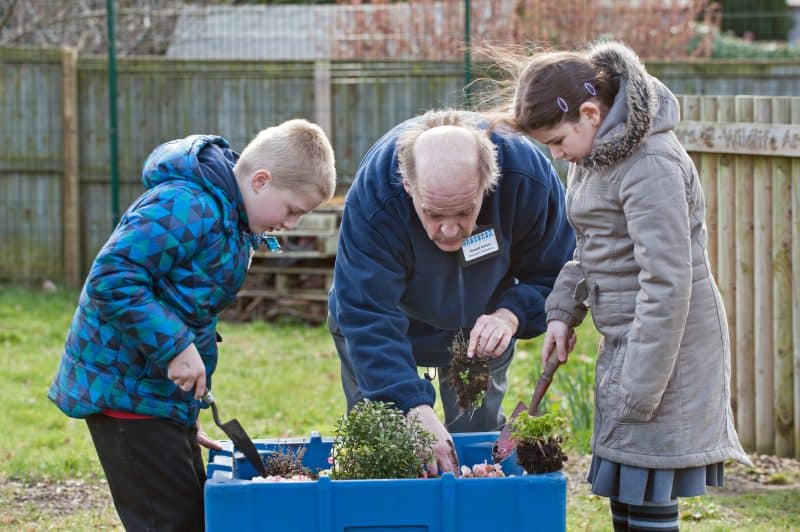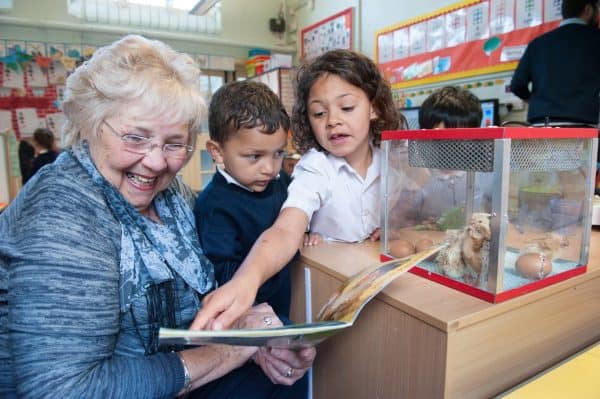The long-bemoaned gap between generations is sometimes accepted as inevitable. But as Lauren Razavi discovers, initiatives in the US and UK are uniting the young and old with impressive results
According to research by charity Anchor, 76 per cent of elderly people in the UK believe their wisdom will never be passed on, while one in five children never spends time with older people who aren’t their grandparents. Meanwhile, the price of childcare continues to soar; the cost of sending a toddler to nursery part time in the UK has tripled over the past five years, with British parents now paying an average of £6,000 in annual fees.
It’s perhaps no surprise then, that programmes that encourage interaction between older and younger people are growing in the UK’s voluntary sector. Charity Intergen facilitates elderly people volunteering at their local primary and secondary schools. The aim is to combat intergenerational stereotypes, improve low aspiration in young people and loneliness in older people, and give older people the chance to work or volunteer in their communities.
I call John my school grandpa, because I already have two grandpas, but John is like an extra grandpa
Betty Tyldesley, 83, speaks fondly of her time as an Intergen volunteer. “It’s been very rewarding to talk to pupils about my experience as a school child during World War II,” she says. “It must be hard for them to visualise what life was like in those days with no TV or telephone, but they were very eager and well-mannered.”
Tyldesley believes that intergenerational learning offers something distinctive to young learners. “I think this is what Intergen is all about: the connection between older people and the children of today,” she adds. “We have so much we can tell them. They don’t all have grandparents, and all our memories are not necessarily found on computers or iPads.”
For the children, the best bit is having somebody out of the ordinary in their classroom. “My favourite school lessons are when we have our volunteer in class with us, because she’s very fun and uses silly words like ‘golly’,” says eight-year-old Katy, a primary school pupil from Norfolk. “And if I don’t understand something she’ll tell me again until I do, so she helps me learn.”

Ronald Avison offers some gardening tips at Old Moat Primary School, Chorlton, Manchester
At Anchor’s care homes and senior centres across the UK, both age groups use tablet computers, digital maps and image archives to help them explain ideas, experiences and interests, delving into the past, present or future depending on what comes up in conversation. This engagement with technology has proven an effective way to bridge the generational gap.
“I call John my ‘school grandpa’, because I already have two grandpas, but John is like an extra grandpa,” says Ben, a seven-year-old from Kent. “He teaches me lots of things. Once he showed me a picture of his train set and it was a really massive, cool one. And it was on his smartphone! My other grandpas don’t have smartphones.” The benefit of mixed-age learning has also influenced change outside of the UK. At Mount St Vincent elderly care home in Seattle, residents have grown accustomed to the regular cheerful disquiet of younger visitors. During the week, this senior citizens’ centre welcomes around 125 children a day to its Intergenerational Learning Center (ILC) — a non-profit nursery and preschool within the residential facility.
Our memories are not necessarily found on computers or iPads
At the ILC, children and the older residents come together for music, dance, art and storytelling. Given that participants are two or even three generations apart, the groups have plenty to learn from each other. Whether it’s reducing misconceptions or passing on knowledge that might otherwise be lost, there are tangible benefits to bringing together the youngest and oldest people in communities.
Intergenerational work clearly leads to positive outcomes for education, social cohesion and community wellbeing. It seems that a simple yet innovative solution can provide remarkable and widereaching benefits. So why hasn’t intergenerational learning become the social norm?
Asa Johnson, service delivery consultant for Anchor’s activities programme, believes that people tend to only think about intergenerational activities and events at certain times of the year such as Christmas or Easter. “The biggest challenge for us is trying to expand those opportunities so the interaction is year-round,” he explains. “Schools and youth groups have limited time and resources, so it can be difficult to set up ongoing schemes. The more we can raise awareness, the more work of this sort we can do.”
Professor Norma Raynes, Intergen’s founder and executive director, continues to be surprised by the power of intergenerational bonding. “One of my favourite stories is about our volunteer, Cindy, who used to visit the park at twilight and often encountered so-called ‘hoodies’,” she explains. “But because she was a volunteer she already knew them from primary school, so she and these teenagers would sit together for hours and chat. “It’s the breaking of stereotype that makes the work we do so important. A lot of the time it’s more about the value of interaction and socialising than it is about learning in the traditional sense.”

Intergen volunteer at Barlow Hall Primary School, Chorlton, Manchester
Photography by Howard Barlow
